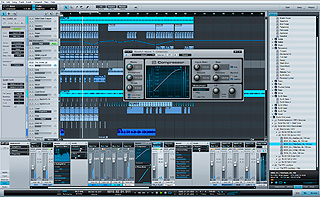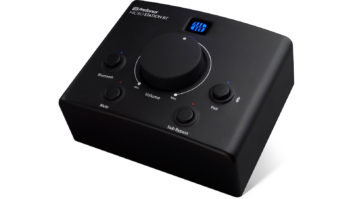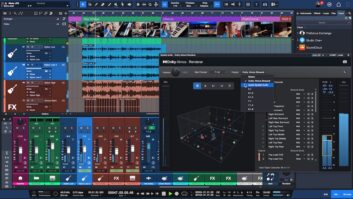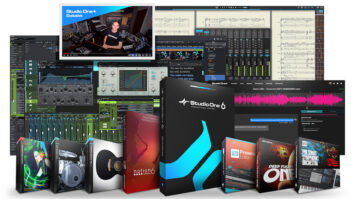
Studio One Version 1.5 adds video support and improved workflow to its feature set.
Last year, when I heard PreSonus was releasing a DAW, I wondered, “Why get into the DAW game now when major players like Digidesign and Apple have spent years tweaking and retooling their already-popular products?” But when I got the first release of Studio One, I was impressed. The company’s “all muscle, no bloat” slogan carried through on the promise of powerful features without extraneous functionality to slow the software down. The 1.5 update offers powerful new features that fill the holes in the original release. It’s as if PreSonus took everyone’s favorite features from the industry’s standard DAWs, packaged them together and then pushed the whole thing forward with major technology innovations.
UNDER THE HOOD
Studio One’s state-of-the-art mix engine features 64-bit, double-precision, floating-point math. The software’s been engineered to perform at this resolution, even within the confines of a 32-bit operating system. To accommodate this mix system, PreSonus includes 25 proprietary 64-bit plug-ins that process in high resolution. And when using third-party VST or AU plug-ins, incapable of 64-bit operation, the intelligent mixer automatically reverts to 32-bit, single-precision, floating-point math. In every scenario I tested, this created an incredibly powerful summing architecture, with pristine quality and generous dynamic range. Additionally, the mixer provides complete automatic delay compensation on every channel. One included plug-in—Pipeline—lets the software treat a hardware insert as a plug-in, with manual delay compensation. A built-in ’scope makes delay calculations simple and user-friendly.
FOCUS ON WORKFLOW
Version 1.5 speaks the project studio’s language where a song is typically carried from composition, tracking, mixing and mastering—all on one platform. To that end, V. 1.5 has a powerful mastering suite that focuses on deliverability. Finished mixes from the Song side of the software can be exported directly into a mastering Project. Here, all of the songs on an album can be trimmed, timed and metered with the K-System (a standard devised by mastering guru Bob Katz); treated with the same 64-bit plug-ins and processing from the mixer; and then assembled into a finished package. If a song is already part of a mastering Project and the mix is revised in the Song page, the mastering Project will update to reflect the new mix. Tracks can be stamped with metadata tags (song titles, artist names and copyright info) through a clear and easily accessible pane. Tagged files can then be exported as MP3s for Web publishing. The software can also burn a Redbook reference copy without needing third-party software. Once the client is satisfied, Studio One can create a disc image to send off for duplication.
Studio One now offers Sound Cloud, a third-party, Web-based service that allows for the sharing of audio by uploading to a remote server and delivering access points to collaborators or clients. The packages range in price, the most basic being free. In each case, you are allowed a certain number of minutes of audio storage, unrestricted in bit rate; you are limited by time, not file size. The Studio One interface for uploading files is very slick and easy to use. As always, files can be dragged and dropped into the window, embedded with the metadata song info and even album art, which will be transmitted with the file.
To further enhance workflow, preset keyboard shortcut templates based on Pro Tools, Logic and Cubase quick keys map common key commands to those with which you are already familiar. In V. 1.5, you can build on those presets by customizing every keyboard shortcut in the software. The software also borrows a useful Nuendo feature that provides a gain control on each individual audio region. This time-saver pushes the necessity for automation to the tail end of the mix, as you can level out a vocal without having to ride the fader. At the same time, some exciting new innovations such as Control Link™ allow easy mapping of any software parameter to a hardware controller. Click the parameter, touch the hardware control, click “Link” and you’re mapped.
LET’S GET COMFY
Getting comfortable with this simple and intuitive software was a breeze. The interface is visually oriented, with slick-looking graphics. For example, the audio configuration pane operates similarly to Pro Tools’ I/O setups, but is easier on the eyes. The combination of visual ease and advanced functionality also proved convenient in the Mix window. Any of the proprietary Studio One plug-ins provided a set of basic controls and meters right within the channel strip. Subtle tweaks were a snap, and the workspace wasn’t cluttered with plug-in GUI panes.
The keyboard-mapping feature is excellent. Other software lets you define key commands, which is helpful, but requires knowing the terminology of the new DAW and ends with manually replacing key commands, which can be tedious. Choosing the Pro Tools preset keyboard configuration found me quickly navigating between windows, initializing transport commands and zooming. I felt right at home in the software immediately. I like V. 1.5’s new keyboard shortcut editor. The presets still exist, but they can be modified and saved as user presets. Where the Pro Tools preset keyboard shortcuts fell short, particularly with regards to the new video-related features, the shortcut editor picked up.
I had some minor complaints about editing in the original version. This is improved in V. 1.5 with a row of tooltips just below the toolbar, which displays possible key + mouse combinations that can be used for additional editing functions. Some of these are similar to the Logic/Nuendo secondary tool, but with a different approach. Learning the proper edit functions of the software using the tooltips is easy, ultimately leading to efficient editing.
There still is no “strip-silence” function. I also hit a few snags in the relationship of the Mixer and Edit windows. Similarly to Logic, edit tracks and mixer channels didn’t necessarily have the same names and often appeared in different orders between the two windows. This proved a bit distracting.
SOUND FOR FILM
One of the more exciting improvements offered in the V. 1.5 update adds post-production functionality. You can playback QuickTime movies within the software and offset the movie from the timecode start of the session. This is a notable improvement, and makes scoring to picture a reality. Even sound effects editing takes place with some ease. I’d like to see synchronization to external devices in future versions, and surround sound would be another welcome addition.
CAN IT SWIM WITH THE BIG FISH?
Studio One feels professional with clear metering, flexible routing options, well-conceived plug-ins with plenty of controls and high-quality summing. Solutions to classic problems like control surface mapping and hardware insert delay compensation are made simple. Throughout the software, there’s a consideration on the importance of metadata. In addition to tagging files with song info, Broadcast WAV files are used exclusively as they have a metadata time-stamp. Touches such as these make this software a beneficial part of a working studio environment.
Studio One also offers a good amount of virtual instruments, a few dozen plug-ins, an innovative mastering suite and 64-bit operation (which has a very impressive sound). Cubase 5 is about the same price, but trades the mastering and 64-bit processing for surround capabilities. Logic 9 prices out about the same and actually offers quite a bit more in terms of software than Studio One. Surround sound, mastering, more additional programs like Compressor and Mainstage, more instruments and full-on post-production functionality are all included. That said, I know people who have been using Logic for years and still don’t feel like they know what they are doing.
If you’re seeking an efficient, pro means of creating and delivering music in modern times, Studio One is a great choice. You’ll move from start to finish with a great sound and smooth operation. I would certainly suggest Studio One Artist to someone shopping for his/her first DAW, and would definitely recommend Studio One Pro to professionals looking to improve their summing quality or ease their workflow. With the growth demonstrated in V. 1.5, it seems that this software will continue to evolve, only improving upon the solid foundation already established.
Brandon Hickey is an audio engineer currently working on an independent film and other projects.

Click on the Product Summary box above to view the PreSonus Studio One Pro product page.







